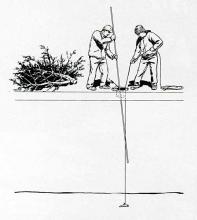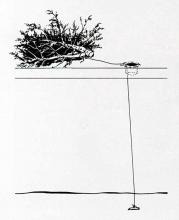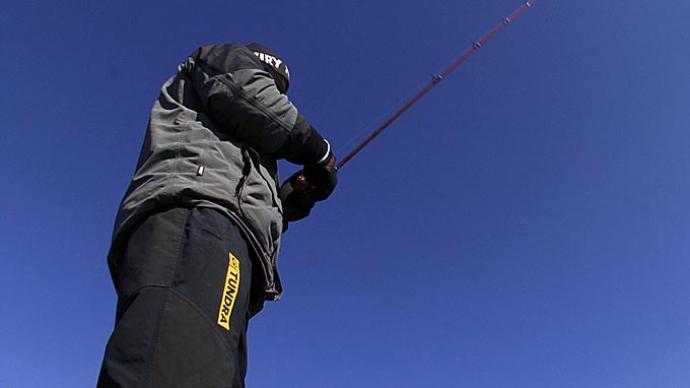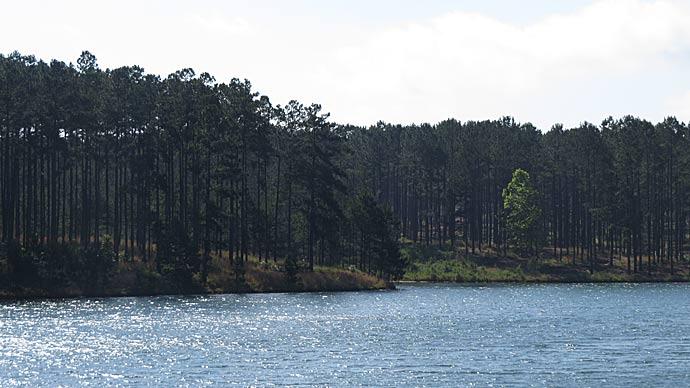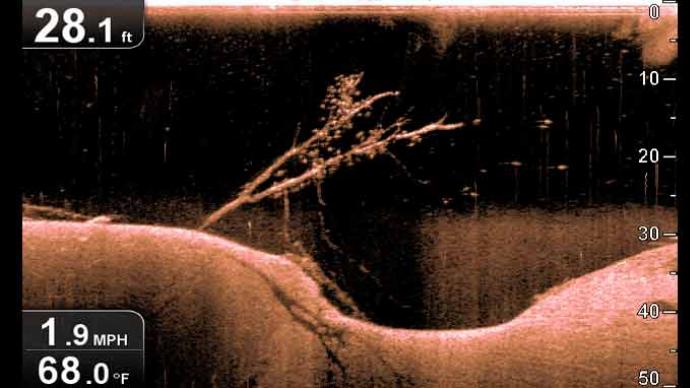
Most pondmeisters already know the importance and benefits that hard cover provides their beloved fishes. The purpose of this article is not to preach to the choir about habitat, rather it is to describe a quick and inexpensive method used to create and anchor habitat, namely brush piles in winter months in cold country.
I know, I know, our great friends a little farther south of the Mason-Dixon line only see ice floating in their tea, but read on, please. This technique will want you to move a little closer to that famous line that distinguishes the North from the South.
Folks have long been acquainted with tried and true methods of attaching cinder blocks, sash weights, and other heavy items to sink their brushpiles and anchor them in place. For larger projects, using blocks and weights can be expensive, time consuming, and cumbersome.
A much simpler method to accomplish the same task involves the use of a duckbill anchor (Figure 1) rather than blocks and weights. A rope or cable is attached to the duckbill anchor, and is driven into the bottom of the pond (Figure2). We routinely use a 10 foot piece of rebar (1/2- inch diameter) to drive the duckbill anchors because most of our brushpiles are anchored in water less than 10 feet and this length of rebar is convenient for us to transport. However, for deeper water, we like to use multiple, 8-10 foot lengths of half-inch all-tread that we assemble on-site with couplers designed specifically for use with all-thread. Ultimately, the size of the driving rod will be determined by the depth of water being used for the habitat project. Be sure to choose a length of rod that is a few feet longer than the depth of the water being used to anchor the brush. Doing so will help account for the depth of the bottom sediments where the anchor will eventually be embedded and it will lend itself to a more comfortable work situation. For example, if you use a 10 foot piece of rebar in 9.5 feet of water, your hammer will be slapping the water before the anchor is properly embedded. On the other hand, you don't want to use a 20 foot stick of rebar to anchor brush in 7 feet of water — you won't be able to reach the top of the rebar to drive the duckbill anchor.
Once the anchor is driven deep enough, the driving rod is removed, and a hard tug on the rope sets the anchor (Figure 3), ensuring that it will not move. The rope is then tied to the brush and the job is done (Figure 4).
Although this method is primarily used for habitat projects in existing ponds, it can also be used to quickly anchor habitat in newly constructed pond basins. The method works decent from a boat, but we tend to wait until winter when we have the quasi-divine advantage of walking on water. Pondmeisters in North-country can appreciate the ice and use it to their advantage for such projects (Figure 5).
For those familiar with habitat projects on ice, you probably learned that creating habitat using cinder blocks gets the job done, but we have found that many times our brush didn't sink where we intended it. During spring- thaw, ice shifting and strong winds can easily move your hard work to undesirable areas. The method described here eliminates that headache — assuming a quality rope or cable is used. The use of this method will only allow the anchored material to drift as far as the length of rope used, which is a function of the depth of water and the amount of slack used while securing the brush.
We've been able to cluster (rope together) up to 5 cedar trees on the surface and successfully anchor them with only one duckbill anchor. Normally, this type of configuration would have required a small trailer load of cinder blocks with lots of loading and unloading. Instead, we are able to carry a handful of duckbill anchors in our pockets. The duckbill anchors keep the brush in place until the brush eventually becomes waterlogged and sinks. This process typically takes less than 5 days when using cedar trees after they hit the water.

There are several sizes of duckbill anchors from which to choose, but we have gotten along well with the Duckbill 68 as shown in the photo (Figure 1). With a quick search on the internet, you can find these anchors for less than $5.00 each. If you choose another size of duckbill anchor, be cognizant of the cylinder's inside diameter and choose an appropriately sized (diameter) driving rod. The Duckbill 68 easily accepts a driving rod with !/2-inch outside diameter, which is a readily available diameter of both rebar and all-thread.
When it comes to creating habitat, your imagination is your only limiting factor. If your pond is lacking habitat, make it a point to get out soon and improve your pond. Your fish will thank you and you'll increase your angling success.
Shawn Banks is a Kansas City based consulting fisheries biologist and owner of Midwest Lake Management, Inc. Serving clients throughout the Midwest, he can be reached at 816-804-5604
Reprinted with permission from Pond Boss Magazine


